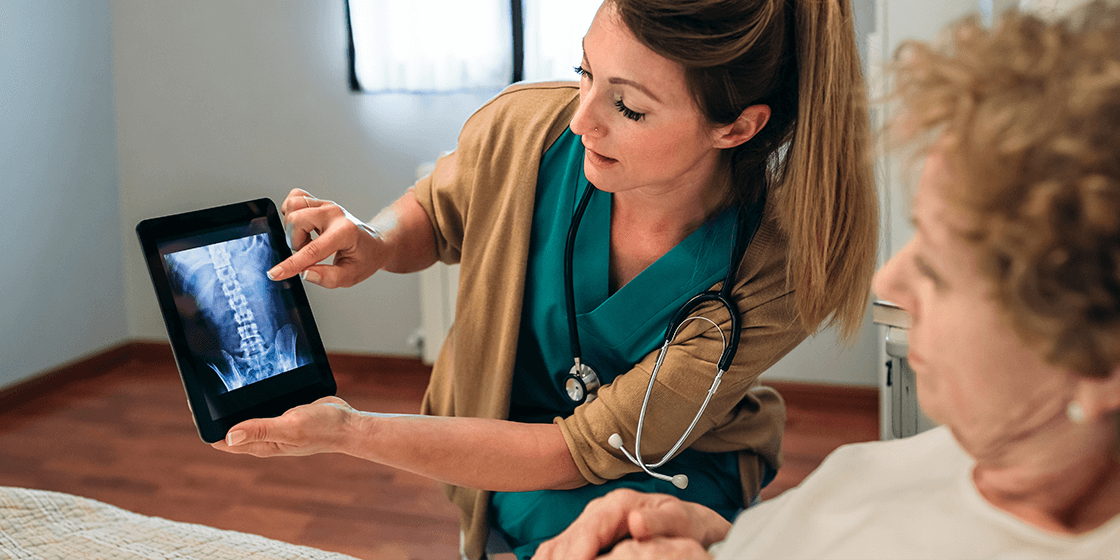An extremely common condition, lumbar spinal stenosis can occur naturally with the aging process. As we age, most of the structures in our body—and our spine in particular—undergo some form of degeneration. Our hair turns gray; our skin begins to wrinkle; and our metabolism tends to slow. And, as many of us have also experienced, the aging process wears away at our bones. Specifically, aging results in the deterioration of cartilage, the growth of bone spurs, and the degradation of intervertebral discs. However, lumbar spinal stenosis can accelerate all of these negative consequences, as well as add more uncomfortable symptoms into the mix.
In essence, lumbar spinal stenosis results in a narrowing of the built-in channels in our spine. When healthy, these channels reserve ample space for our nerves to travel through the spinal canal and our foramina. However, when these channels narrow or develop bone spurs, our nerves can become compressed or damaged. Pain, numbness, tingling, and loss of sensation in the lower back and legs can appear, disrupting our everyday activities.
In particular, back pain accounts for a major cause of missed days at work and lost time with friends and family. And, in many cases of lower back pain, spinal stenosis is the culprit. Even so, you can use a variety of treatments to combat the painful and debilitating symptoms of lumbar spinal stenosis. Many of these tried-and-true methods have been around for decades. However, a few more modern approaches—like minimally invasive lumbar decompression surgery—have expanded surgical relief options for patients.
Traditional Treatments
Medication & Injections
Doctors often recommend pain-relieving medications and injections as a first plan of attack to address lumbar spinal stenosis. Specifically, over-the-counter NSAIDs, such as ibuprofen, provide an effective offense for lower back pain. For more severe cases, however, your doctor may recommend prescription strength medications. In addition to traditional pain medications, your doctor may also suggest anti-seizure medications to dull overactive or “screaming” nerves.
Furthermore, corticosteroid injections can deliver short-term relief from moderate to severe pain and inflammation from lumbar spinal stenosis. Keep in mind, however, that neither oral medications nor steroid injections will provide a long-term option for pain relief. For enduring relief from pain, combine these alternatives with other modes of treatment that address the underlying cause.
Hot/Cold Application
Another traditional, yet beneficial, treatment for pain involves the application of heat and cold to the affected area. The use of ice can provide topical relief from pain. Whereas, the application of heat can loosen up tense muscles and increase the healing flow of blood to the area. However, when combined, these treatments can both reduce inflammation and promote accelerated healing.
Physical Therapy
Working with a physical therapist can teach you techniques for improving the strength and flexibility of your lower back—two essential qualities for maintaining spine health. When in pain, we tend to avoid movement, making our joints and muscles even stiffer. This can exacerbate the painful symptoms of lumbar spinal stenosis, accelerating a slew of degenerative side effects.
According to the National Institutes for Health, doctors diagnose spinal stenosis more commonly than just about any other spinal disorder. With thousands of newly reported cases in the US every year, options for stenosis treatment are continually multiplying and improving.Progressive Treatments
Lifestyle & Diet
It may seem overstated, but a healthy diet and lifestyle can greatly affect your wellness. Furthermore, regular exercise and nutritious eating can encourage a healthy weight and prevent tissue inflammation.
Being overweight, however, can lead to excessive stress on the body—especially, on the spine. Because the spine supports the entire torso and upper body, excessive weight can degrade your joints, spinal discs, and vertebrae. This translates to bulging or herniated discs, thickening ligaments as they struggle to support the spine, and joint compression.
Traction or Inversion Tables
Visiting a chiropractor can vastly improve your quality of life if you suffer from lumbar spinal stenosis. As an allied health professional, a chiropractor evaluates and adjusts joints that suffer from malalignment. Additionally, chiropractors restore space in the spine through the use of manual adjustments and a variety of instrument-based techniques. In particular, you may find a traction or inversion table especially useful for relieving your pain.
Furthermore, chiropractors use traction and inversion tables to restore space in arthritic, fractured, stenotic, or degenerated spines. Whether you choose to lie horizontally on the traction table or upside-down (inverted), decompression is the ultimate goal. Using mechanical pull (i.e. the traction component) or gravity, you can regain lost space between compressed vertebrae in your spine.
Minimally Invasive Lumbar Decompression
Finally, a minimally invasive lumbar decompression procedure can provide an effective relief option for individuals who have severe spinal stenosis. Typically, your surgeon can perform this outpatient procedure in as little as an hour, sometimes without the use of general anesthesia. With assistance from specialized instruments and scopes, your surgeon can remove any obstructions, like bone spurs or thickened ligaments. Furthermore, this state-of-the-art procedure boasts high success rates with virtually non-existent side effects. For more details on lumbar decompression procedures, see our treatment pages on lumbar foraminotomies and laminectomies.
The treatments presented above are only some of the exciting relief options for lumbar spinal stenosis. Working closely with a physician, you can identify the minimally invasive treatments that will work best for you. It’s time to take control of your back pain and return to life!
